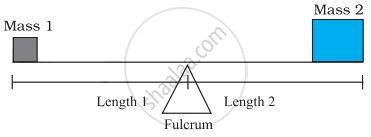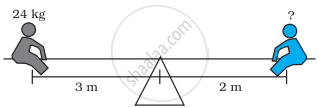Advertisements
Advertisements
Question
Unequal masses will not balance on a fulcrum if they are at equal distance from it; one side will go up and the other side will go down.
Unequal masses will balance when the following proportion is true:
`("mass"1)/("length"2) = ("mass"2)/("length"1)`

Two children can be balanced on a seesaw when
`("mass"1)/("length"2) = ("mass"2)/("length"1)`. The child on the left and child on the right are balanced. What is the mass of the child on the right?

Solution
It is given that, for balancing.
`("Mass" 1)/("Length" 2) = ("Mass" 2)/("Length" 1)`
According to the question,
Mass 1 = 24 kg, length 1 = 3 m and length 2 = 2 m
∴ `24/2 = ("Mass" 2)/3` ......[By cross-multiplication]
⇒ Mass 2 = `(24 xx 3)/2` = 36 kg
APPEARS IN
RELATED QUESTIONS
If b is the mean proportion between a and c, show that: `(a^4 + a^2b^2 + b^4)/(b^4 + b^2c^2 + c^4) = a^2/c^2`.
Using the properties of proportion, solve for x, given `(x^4 + 1)/(2x^2) = 17/8`.
Find the third proportional to a2 – b2 and a + b.
4.5 g of an alloy of copper and zinc contains 3.5 g of copper. What weight of copper will there be in 18.9 g of the alloy?
If x, y, z are in continued proportion, prove that: `(x + y)^2/(y + z)^2 = x/z`.
Choose the correct answer from the given options :
The fourth proportional to 3, 4, 5 is
3 : 5 : : `square` : 20
A particular high school has 1500 students 50 teachers and 5 administrators. If the school grows to 1800 students and the ratios are maintained, then find the number of teachers and administrators
What number must be added to each of the numbers 4, 6, 8, 11 in order to get the four numbers in proportion?
If x, y and z are in continued proportion, Prove that:
`x/(y^2.z^2) + y/(z^2.x^2) + z/(x^2.y^2) = 1/x^3 + 1/y^3 + 1/z^3`
